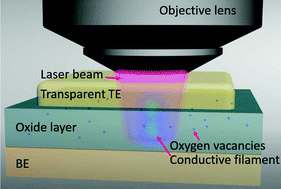A nondestructive approach to study resistive switching mechanism in metal oxide based on defect photoluminescence mapping†
Abstract
The mechanism of resistive switching in metal oxides is a widely studied topic with interest in both fundamental physics and the practical need to improve device characteristics for memory based applications. Various experimental approaches were employed to reveal the different aspects of resistive switching; however, there is still a debate on the switching mechanism due to the lack of nondestructive microscopic characterization tools to monitor the oxygen vacancies. In this study, a novel approach using photoluminescence (PL) mapping was developed to study switching dynamics in metal oxides. By monitoring the emission properties with a confocal PL system, information regarding the switching mechanism can be obtained. The nondestructive nature of this approach allowed us to make comparisons between different switching conditions and endurance cycles. SrTiO3 based switching devices were used in the study. The distribution of oxygen vacancies can be positioned by mapping the integrated intensity of oxygen vacancy emission on a transparent top electrode, and both interface switching and filament switching can be distinguished. Moreover, the endurance study revealed a sudden rise in the emission intensity correlated with the device failure, which indicates an abrupt increase in the localized density of oxygen vacancies that results in an irreversible set process for the conductive filament.



 Please wait while we load your content...
Please wait while we load your content...